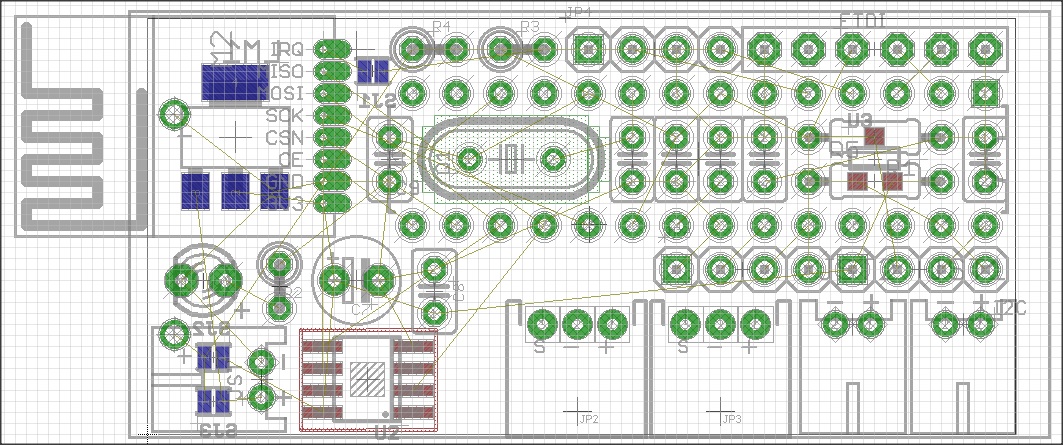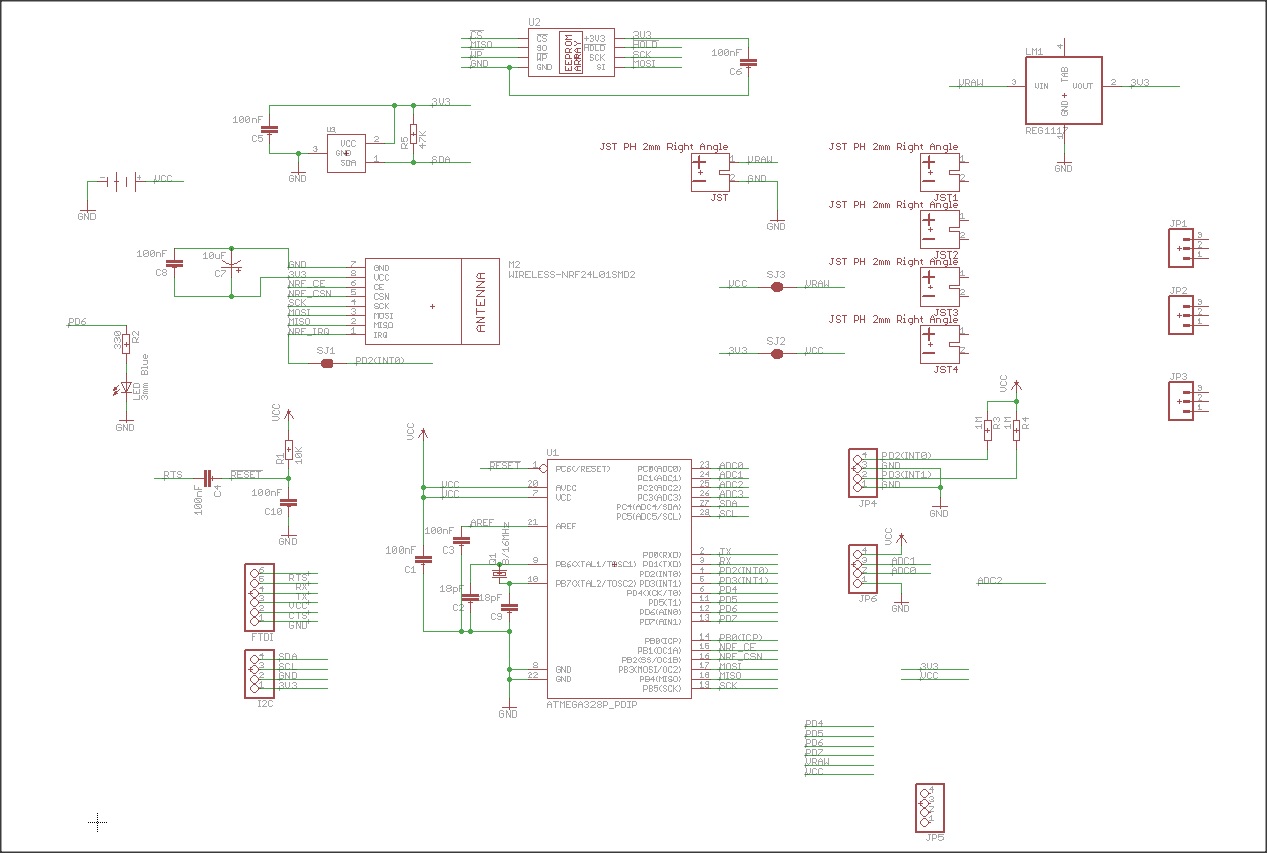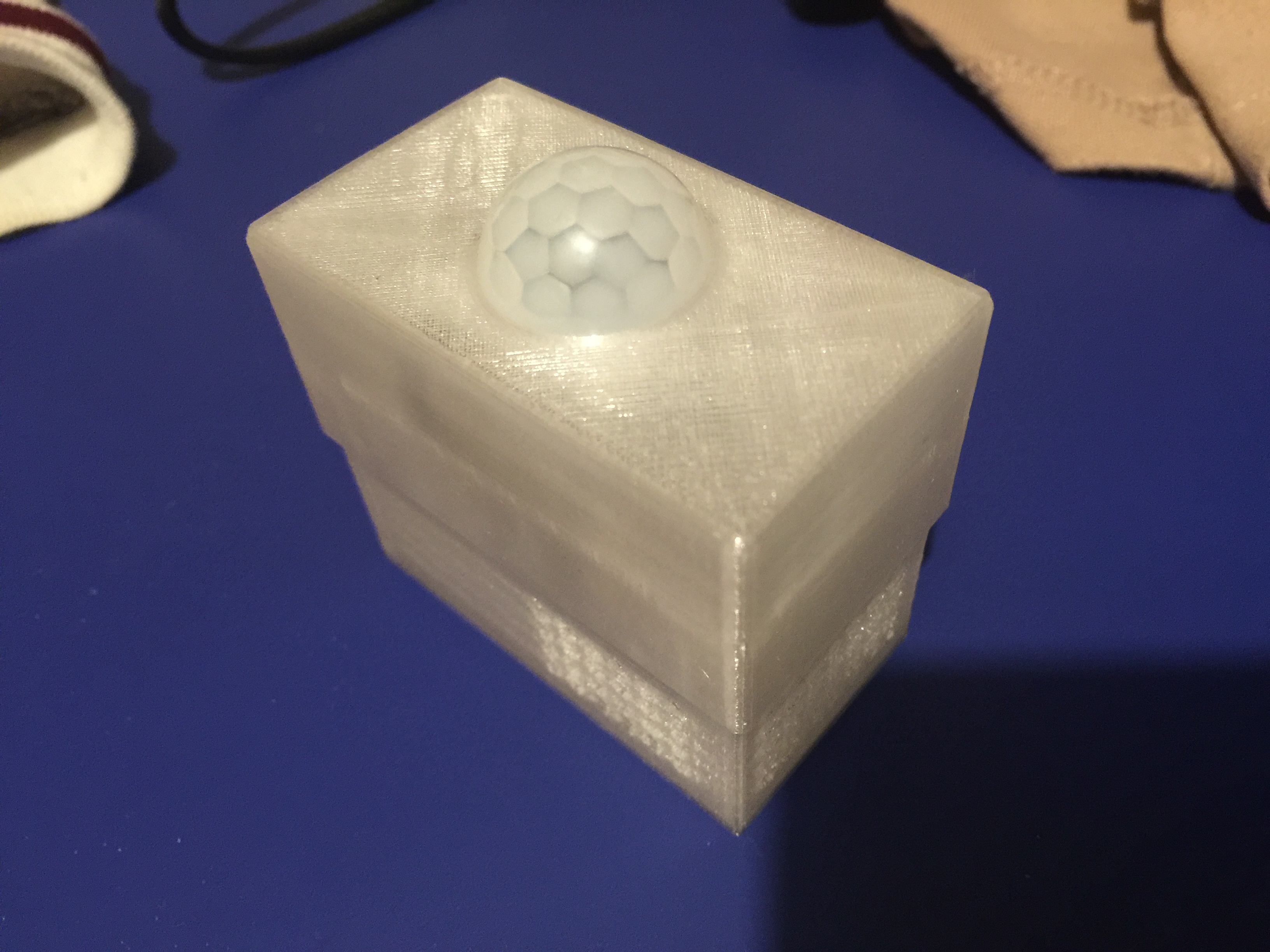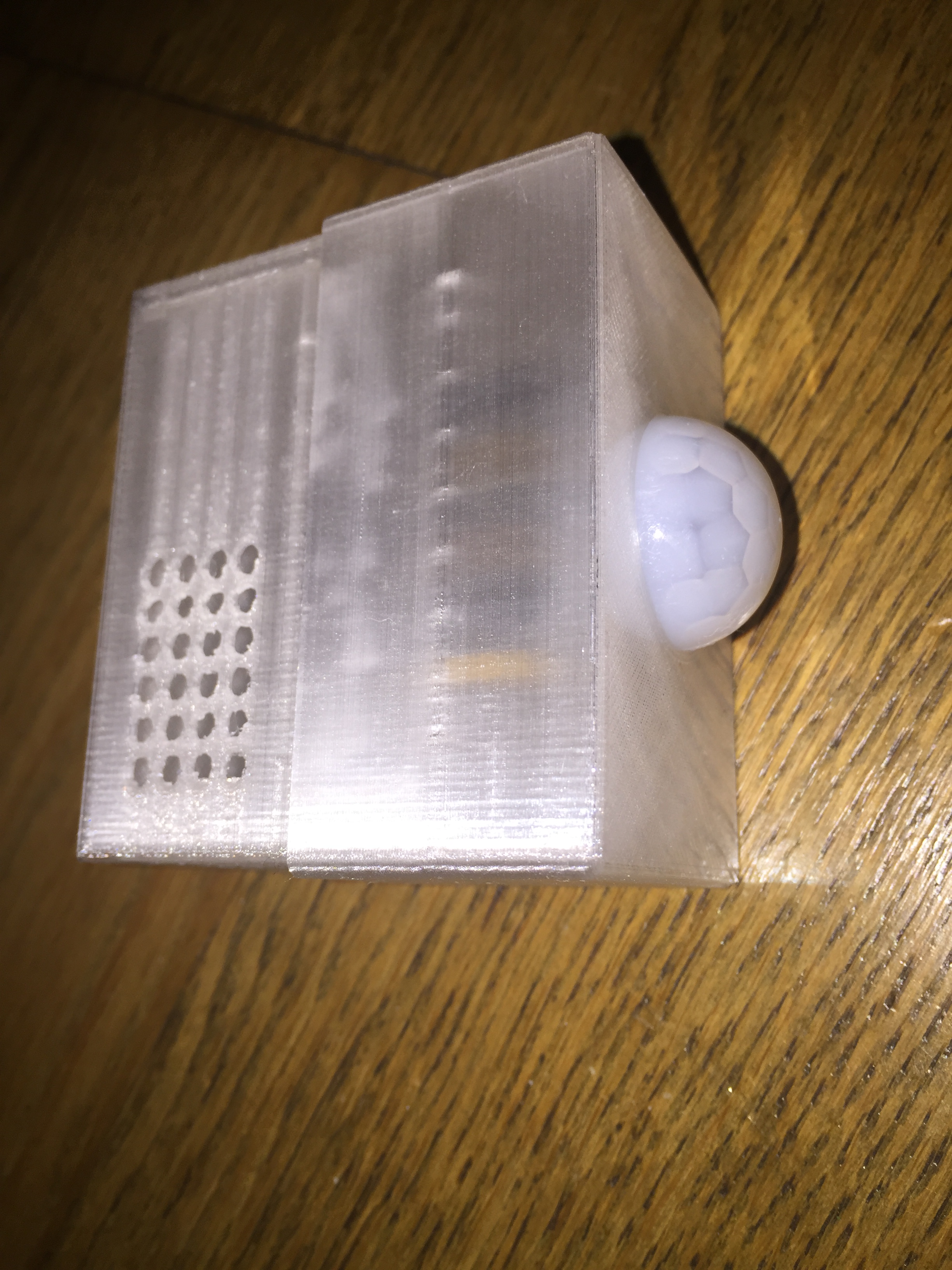Battery based atmega328p sensor (no SMD)
-
-
Just added some info to test the forum connection.
Board is fixed, BOM is fixed. Instructions need to be elaborated more.
-
Added a reply to see the result.
-
It seems that the BOM is empty.
-
As mentioned, work in progress ...
-
BOM added
-
Added some pictures and text.
-
This is a perfect node. I have a few of these with different sensors and also got a few 3D printed cases for 2xAA PCB fit
-
Do you use both NRF headers on different nodes, or always the same header ? I plan on improving this node, and I think only 1 NRF connection header is needed (my preference is in the same axis as the atmega328, like in the picture).
What is your opinion on the two NRF headers ?
-
I am using both NRF headers depending on the I2C module I am using. Somethings the tip of nrf24l01+ is not going well with a wider sensor.
Having said that this is not a problem and one connector can go.Another problem I am facing is that SDL and SDA on all sensors are differently placed. I wonder if this is possible to swap with a jumper?
What's your view?
-
@alexsh1 In my AC board I have added jumpers to swap the position of the SDA and SCL pins. I plan to add those jumpers to a new version of this battery based node. It will give more flexibility.
I also sometimes use a wider Temperature/Humidity sensor board (HTU21D) instead of the SI7021 boards with GY-21 marking. The I2C pins are swapped, and the width is indeed different.
I have also reconsidered how to connect the other pins, so I'm thinking of using angled JST connectors (like the power connector for instance).
Using only 1 header for the radio will allow more clearance between the I2C pins and the rest of the connectors.
I'm also quite happy with the "smd" version of the NRF24L01+ boards. Very small and yet works about the same range. This removes the need for the big 2x4 header completely. I used it on my very narrow board.
-
@GertSanders I had to use Dremel to trim down HTU21 board (I posted photos on the forum). There are no components so I do not understand why they have a wider board.
JST connector is useless in my case as I am powering all nodes from batteries or FTDI. Potentially, you may remove it too.
In relation to SMD nrf24l01+ I think it is brilliant. I have been using one with your narrow board and another one with sensebender. They really save a lot of safe for the header and the board itself. Alternatively, you may be designing the board with a built-in nrf24l01+., but it would require some SMD soldering.
-
@alexsh1 said:
nrf24l01+
Soldering a nrf24l01+ is beyond my capacity for the moment, I do not plan to do that. But the modules with 1.27mm pins (the "smd" variant) are feasable.
Someone already made a board with built in nrf24l01+ and PCB antenna:
https://www.openhardware.io/view/31/MySensors-Stable-NodeI'm now going to make a variant of the narrow board for the LNA+PA smd version. These boards also use the same 1.27mm spacing and castelated pins, but the pin connection is different, so not compatible with the smaller non PA+LNA smd boards.
I have seen small nrf24l01+ smd boards with the same pinout as the larger PA+LNA smd nrf24l01+ boards. So maybe we should "standardise" on that pinout.
Small smd version pinout (the one I use):
VCC (1.9 - 3.6V)
GND
CE
CSN
SCK
MOSI
MISO
IRQLarger PA+LNA smd version:
VCC (2.2 - 3.6V)
CE
CSN
SCK
MOSI
MISO
IRQ
GND
-
@GertSanders Yeah, I understand - this is a very small chip.
I looked at this board with built-in nrf24l01+ but my SMD skills would not allow me to do it. I may get away with a few components, but not with the whole board. I am looking at a few soldering/rework stations right now to allow me to do SMD, but currently I do not have tools needless to say about skills.
With regards to nrf24l01+ SMD, I purchased a pack of 6 from Aliexpress and they have the following pin-out:
VCC
GND
CE
CSN
SCK
MOSI
MISO
IRQThese are the same boards you used as well (or similar in terms of pin outs) and I suggest to stick to that. LNA+PA SMD is a special one - how many would really need it? I have LNA-PA installed on my GW and can install one one the node if I have to, but out of all my nodes I only have normal and SMD ones.
-
@GertSanders The other point is that your node is small and compact enough (my limitation was the 2xAA case in terms of length and width). Is it really necessary to go fully into the SMD?
-
@alexsh1 . No, I do not plan for this board to be full smd. The smd version of the atmega328 is also wider then the DIP version. So for very narrow boards, it would not make sense to use the AU variant of the cpu. The narrow board will stay a DIP based - mostly throughhole board. So will this board.
I am tempted to try a version with 0805 size smd resistors, which are still soldarable by hand, and yet much smaller then 1/4W (7mm) resistors I use now. But again, no real use case right now.
-
This is what I mean in terms of size...

-
@alexsh1 Nice box

Related to size: I plan to keep the board size within 50 x 24mm so that I can get 2 nodes out of a 50x50mm board. It also corresponds exactly to the size of a 2xAAA battery holder, which is a little smaller then the 2xAA battery holder you use.
Here is the preview of where I am at now. This still needs to be routed, but for the moment I'm looking at placing components in the most efficient way (and trying to imagine how I would route wires around this node in tight spaces.
I'm also planning to include ATSHA204 and flash to make it a full MySensors compatible node (minus the MYSX connector, not sure what to do with that yet).

The working file schematic is still in "movement"


-
Just a quick hello to say your Battery based atmega328p sensor (no SMD) and the companion boards are exactly what I was looking for. Ordered 10 of each today and cant wait to get cracking on building them.
Great work btw
-
@GertSanders you decided to keep JST I see. A few more jumpers here

Also do you assume soldering ntf24l01+ directly onto the board or via pins?
-
@GertSanders Have you been thinking about powering it with a different source?
I have come across 26650, which is a super rechargeable battery (5000mAh) and very compact.
-
@alexsh1 said:
26650
Fully charged these batteries are 4.2V, which is too high for the radio. In terms of cost, they require a special Li-Ion battery loader. Cutout voltage is aroud 2.5V. Capacity wise they would allow a node to work 3 years. Personally I'm happy with something over 1 year at 10th of the cost.
Related to your other question on the mounting of the NRF: if a battery is needed, I would need 1.27mm header to solder the radio in place, as one battery terminal sits below the NRF module. Without a battery holder mounted under the board, this is not needed. Personally I'm still looking for a positioning of the NRF module on the PCB directly and which allows the mounting of the batteryholder under the PCB. The NRF as it is positioned in the screenshot needs to move.
JST connectors seems a good choice in terms of cost, size and avoids wrong connections due to the tab in the connector (but you can still make mistakes on the wired end of course).
-
@GertSanders said:
@alexsh1 said:
26650
Fully charged these batteries are 4.2V, which is too high for the radio. In terms of cost, they require a special Li-Ion battery loader. Cutout voltage is aroud 2.5V. Capacity wise they would allow a node to work 3 years. Personally I'm happy with something over 1 year at 10th of the cost.
Well, not exactly. Have a look here: http://forum.mysensors.org/topic/3309/powering-nodes-3-3v-with-18650-26650/7
The cost of LDO is about Eur 1 for 20 pieces including shipping from HK
No charger is needed (and I have one away) -> TP4056 with Battery protection is the answer. Just plug it into the USB to charge. The cost is Eur 2-3. The only cost here is battery itself. With PCB it is around Eur 10 vs 2xAA (or 2xAAA), which is what? Eur 4-5? Fine, but this is rechargeable and you can use it in other projects.
-
@GertSanders : nice board and concept
 in my latest mytinycamel (I re-routed it recently) I have mysxconnector and 3xi2c , 24x49 but 0603 smd...and on this one radio module is on bottom...(I would like it on top but mytinycamel is a little bit room eater..but it's a cool power sequence so for fun!) I will try to upload it (and other stuff) maybe this week-end. I have routed something for lora too...32bits ;), still smd..
in my latest mytinycamel (I re-routed it recently) I have mysxconnector and 3xi2c , 24x49 but 0603 smd...and on this one radio module is on bottom...(I would like it on top but mytinycamel is a little bit room eater..but it's a cool power sequence so for fun!) I will try to upload it (and other stuff) maybe this week-end. I have routed something for lora too...32bits ;), still smd..
@alexsh1 : I think it's a matter of taste for instance, mytinycamel (my board) is not so expensive, and I can use only one 1.5v AA or AAA and last for years! put two in //, or don't ask me with a cheap lr14 type C 8000mah I have not tested yet lol! primary batt (aa/aaa/C) are cheap, in lithium version very low self discharge..not rechargeable but you have very often an aa/aaa batt somewhere
for instance, mytinycamel (my board) is not so expensive, and I can use only one 1.5v AA or AAA and last for years! put two in //, or don't ask me with a cheap lr14 type C 8000mah I have not tested yet lol! primary batt (aa/aaa/C) are cheap, in lithium version very low self discharge..not rechargeable but you have very often an aa/aaa batt somewhere  dilemma everywhere!
dilemma everywhere!
-
@scalz LR14 Type C is a huge battery. 26650 is not. Though I agree it is a matter of taste/view. I have been using 18650/26650 to power up some projects and they performed well and universal - can be recharged and used for a power hungry projects and in my torch.
-
@alexsh1 : lr14 diam 25.5 and length 49.5. 26650 is 26x 67...so lr14 is smaller (but need a switch reg). I agree too, 26650 is a nice rechargeable one for hungry projects

-
@scalz You are right re size - perhaps I was comparing it with type D. However, in terms of capacity, would you get a proper 5,000 mAh (not Trustfire capacity lol) out of lr14? We are not comparing apples with apples here as 26650 is 3.7V (and not 1.5V)
For super power demanding projects I use this one:
http://www.gearbest.com/rc-model-accessories/pp_143333.html?currency=GBP&gclid=CNupk7T0pMsCFcO4GwodKFAO6g
-
BTW, for projects now I'd favour AA sized 3.2V LiFePo4 (1 battery) or AA-sized 1.6V NiZN (2xbatteries) or AA-sized 1.5V Lithium rechargeable (2xbatteries)
This is concerning 3.3V power supply obviously.
-
@alexsh1 : cool
 not comparable, I know, lol..I just wanted to share other alternatives (26650 sized) as lr14 are very cheap in pack and can last very long time (with a booster 0.7v-1.5 to 3V) and you always have 3v during the whole life, can use every drop of power. but booster is not the best efficient for big hungry application. other 9v batt are nice too
not comparable, I know, lol..I just wanted to share other alternatives (26650 sized) as lr14 are very cheap in pack and can last very long time (with a booster 0.7v-1.5 to 3V) and you always have 3v during the whole life, can use every drop of power. but booster is not the best efficient for big hungry application. other 9v batt are nice too  and lipo can vent or good quality are expensive (good quality = true mAh, secure and low selfdischarge. but as you said it's rechargeable). And I am designing a lipo node too so..
and lipo can vent or good quality are expensive (good quality = true mAh, secure and low selfdischarge. but as you said it's rechargeable). And I am designing a lipo node too so.. 
sorry for ot ..
-
@scalz I suggest we move this discussion to http://forum.mysensors.org/topic/3309/powering-nodes-3-3v-with-18650-26650/2
6 x 1.5V LR14 on Amazon are £7 meantime 26650 3.7V 5000mAh is £9. Obviously one needs 2 for a project so its it £2.2 vs £9, but I am looking at it from a different angle. 26650 is a universal buy for me as well as an investment - I can power a project with, say, a motor or solenoid or connect a solar panel to charge the battery.
This is just my 2 cents
-
This post is deleted!
-
@GertSanders I really like this board - you are getting better and better!

You have now EEPROM? And the LED now on D5? You really like changing LED pin.
Somebody was asking for PIR on the slim node.
Well, another teaser from me using previous version of your board (AA battery compartment and I am altering STL file to have it also for AAA battery case).

-
@GertSanders What are you planning to use for SJ4 and SJ5? Soldering or switches? I was thinking about the following:
-
@alexsh1
SJ4 and SJ5 are solderingpads. I find that I do not change the function of the node once it is set up. No point in using switched, when the switch action only happens once.
-
@GertSanders i know you have not done testing but can you give up heads up when you share it on oshpark - very keen to test it myself. Dank je
-
Some pins moved again. I have not yet ordered this, I normally sleep on it for a few days, then check again, and if I feel OK that no more details need to move, I will trigger an order and share. I'll let you know when that happens.
I'm still wondering whether I should put soms test-pads in place, to allow ISP programming of a bootloader after the mcu is put in place. It would require some round test-pads on the bottom. I will think about this tomorrow after I have slept on it.
UPDATE: found a small error in my schematic: C10 is not needed. So rerouting will be needed, I want this location for something else.
-
board is ordered and shared from OSHPark: https://oshpark.com/shared_projects/2uuSjIIQ
-
@GertSanders said:
board is ordered and shared from OSHPark: https://oshpark.com/shared_projects/2uuSjIIQ
Thanks for this! Can you please share the BOM file?
I placed my order already!
-
I will add it on OpenHardware.io
-
@alexsh1
In what capacity do you get the AA size LiFeP4 batteries ?
-
@GertSanders said:
@alexsh1
In what capacity do you get the AA size LiFeP4 batteries ?@GertSanders
OK, I have a couple of 14500 LiFeP4 3.2V each. They are only 600mA. They are not my favourite though. I also have (1) lithium rechargeable AA 1500mA 1.5V (charging 5V from USB) and (2) NiZn AA 1.6V 2200mA - these are my favourite so far.The problem for me is that my new charging device has not arrived yet from China and I cannot charge NiZn. I have discharged a few and did not a chance to charge them
-
Is there a case/housing available instead of printing an own one?
-
No, this board was not made for a specific housing. It just fits the dual AA(A) battery holders.
-
Thanks for your feedback. Do you have a link for a AA battery holder? I could only find AAA holders with pins.
-
@gloob have you tried to use google? There are plenty of 2xAA holders on eBay as well.
http://uk.farnell.com/keystone/2462/battery-holder/dp/1702630
-
When you read the data sheet correctly you can see, that the distance between the pins is different for a AA and AAA battery holder. That`s why I was asking if somebody can recommend a holder that fits.